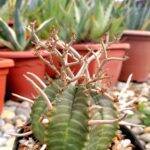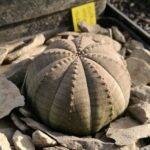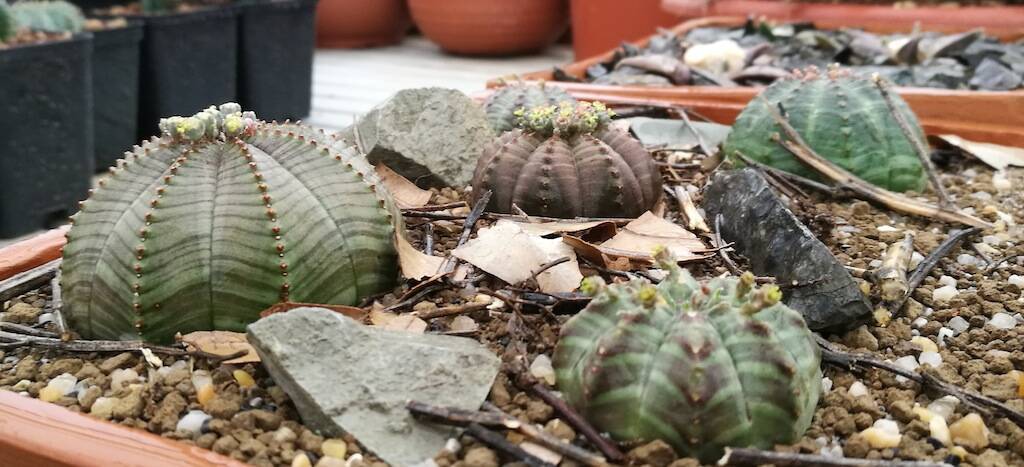The succulent species belonging to the Euphorbia family (Euphorbiaceae) are appreciated and cultivated by many cacti lovers. The variability in the forms and some cultivation affinities with cacti make these plants an excellent alternative to “vary” the collections of succulents. However, it is essential to know the primary main needs of Euphorbias to grow them successfully. Euphorbiaceae is the fourth largest family of angiosperms, i.e. flowering plants. The Euphorbiaceae are divided into 5 subfamilies, 300 genera and 6.000 species, many of which are succulent. These plants have a very variable bearing: they can be in the form of small grasses, or in the form of real shrubs; they can be columnar or caespitose, very thorny or with a perfectly smooth stem. Also, they can hold leaves, but they can be devoid of them. Euphorbiaceae, unlike Cactaceae (exclusively originating from the Americas) come from almost every part of the world, except, of course, the Arctic and Antarctic areas. Some species come from Africa, others from the Americas or from Asia.
You can deepen the knowledge of Euphorbiaceae in the following article, with description, images, curiosities and cultivation techniques specific to this plant family. (…)
Historical notes

The first succulent Euphorbia was discovered between 25 B.C. and 18 A.D. by King Juba of Mauritania (present-day Morocco). The name given to the family has curious origins: after having found out one of these plants (perhaps E. resinifera or E. officinarum) on the Atlas Mountains, it seems that King Juba gave it the name of his doctor, Dr Euphorbus, drawing inspiration from the translation of the term, which means “well-fed”. Some non-juice species of Euphorbia were instead known for years, since the time of Ancient Greece and were called “Tithymalus“. The two names co-existed until the time of Linnaeus, who combined them under the name Euphorbia in 1753. Nowadays the name Tithymalus survives but only indicates a subgroup of Euphorbia.
Problems with the classification of plants and the distinction into families? Here you’ll find a perfect article for you.
Features

The appearance of Euphorbia, as I said, can be extremely variable. The common denominator of this family, however, is the sexual organ of the plant. In this case, we do not speak of “flower” but of “cyathia”. These are very specialized floral structures and at the same time very different from flowers as we understand them. The cyathiazians are, in fact, small in size and can be unisexual or bisexual. Basically, inside unisexual cyathia, there is a single female flower or some male flowers, while in bisexual cyathia there is a female flower surrounded by male flowers. This is one of the main differences between succulent Euphorbiaceae and Cactaceae.
Cultivation
Since they come from all over the world, the various Euphorbia species have very different cultivation needs. Even staying in the “field” of succulent Euphorbias, you can have plants that need a lot of light as well as plants that adapt well to reduced exposure. Some Euphorbias can withstand prolonged drought well and others that do not withstand long periods of dryness. Some Euphorbias can withstand low temperatures (even below zero) and Euphorbias that do not tolerate low temperatures below 7-8 degrees.

For my choice (and not to deviate too much from the regime of cultivation of my cacti) I cultivate only Euphorbia able to tolerate the cold. I have specimens of E. obesa, E. enopla, E. ferox, E. meloformis, E. canariensis, E. resinifera. I have also tried to grow E. candelabrum but with poor results because of its poor tolerance to low temperatures. As for the species I grow, I don’t have particular problems: they are quite resistant plants and can be cultivated more or less like cacti. I keep them in soils a bit richer in organic matter than cacti, both based on the classic lapillus, pumice and peat, and on clay and inerts such as pumice, sand and river gravel. I water them only during the growing season, from April to September, leaving them completely dry in the remaining months of the year, and I keep them in greenhouses not shaded, therefore with good exposure.
Soils for cactus and succulent plants: all my “recipes”.
Euphorbia obesa

And now just two words about Euphorbia obesa, much appreciated and widespread among succulent lovers. It can be said that this plant is the succulent par excellence: in its juvenile stage, it’s perfectly round, “fat”, in fact, without thorns and with a harmonious look, embellished by the streaks on the surface of the stem. Growing up, it tends to assume a short cylindrical bearing while maintaining the thick stem inside which it stores its water reserves.
Reproduction

Euphorbias can be easily reproduced both by seeding and cutting in the spring months. In this second case, it is good to be careful when cutting because many species contain latex that can be toxic in some cases. To stop the release of latex, once cut a branch of Euphorbia (wearing gloves!), you can immerse it in water for a few minutes, then let it dry for at least a couple of weeks and bury it in pumice or sand until it has taken root. The cuttings can then be repotted into suitable soil.
How to propagate cacti and succulents from seed: the whole procedure.
Curiosity

Some Euphorbia species are very usual and are easily found on the market, especially at certain times of the year. What is commonly called “poinsettia“, in fact, is nothing more than a Euphorbiaceae (E. pulcherrima). In the winter period, following some cultivation expedients (in particular after having kept it almost in the dark for a few months) this plant produces deep red apical leaves, becoming very showy and decorative. Another very usual species is E. milii, commonly called “Thorn of Christ”. It’s a Euphorbia with thin stems covered with thorns, at the apex of which sprout colourful and very decorative small inflorescences. There are no particular historical findings, but this plant owes its common name to the legend according to which the crown of thorns placed for mockery on the head of Christ was made by weaving shrubs of this Euphorbia.
SUBSCRIBE TO THE SITE – If you liked this article, subscribe to the site to have access to all the contents for one year or three months depending on the formula you choose. Here you will find terms and conditions.
SUBSCRIBE TO THE NEWSLETTER – If you want to receive the free newsletter every time new content is published (even if you have not subscribed to the site), fill in the fields at this link!
© The texts, videos, photos and graphic elaborations of the site “Il fiore tra le spine” are original material and are covered by copyright. It’s forbidden to reproduce them in any way.



